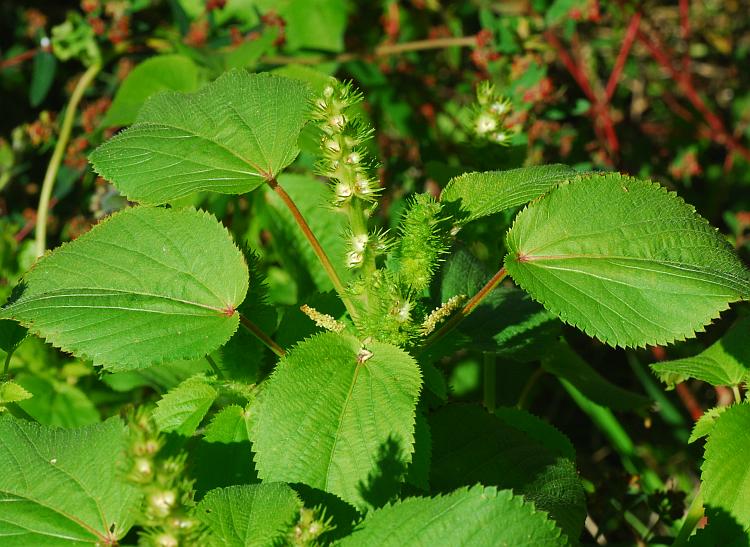Acalypha ostryifolia Riddell ex J.M. Coult.
Roughpod Copperleaf

Native
CC = 1
CW = 5
MOC = 40
© SRTurner
Acalypha ostryifolia Riddell ex J.M. Coult.Roughpod Copperleaf | |
 |
Native CC = 1 CW = 5 MOC = 40 |
© SRTurner |
|
Family - Euphorbiaceae Habit - Taprooted, monoecious, annual forb. Stems - Ascending to erect, to 70 cm, often slightly zigzag above the midpoint, branching, moderately to densely pubescent with short, strongly curved hairs, also with longer, straight hairs toward the tip, often many of these gland-tipped. Sap clear.
Leaves - Alternate, simple, mostly long-petiolate. Petioles 1/5 as long to slightly longer than the blade, much longer than the inflorescence bracts. Leaf blades 1-8 cm long, narrowly to broadly ovate or heart-shaped, those of at least some of the leaves shallowly cordate at the base, others merely rounded, angled or tapered to a bluntly or sharply pointed tip, the margins with relatively numerous (18-36 on each side) closely spaced, usually sharp teeth, the surfaces (especially the undersurface) sparsely pubescent with straight to curved, more or less appressed hairs.
Inflorescences - Staminate inflorescences axillary, 1-2 per node, short-pedunculate, dense, cylindric, to 1 cm, lacking an inflorescence bract or this minute and irregularly ovate. Pistillate inflorescence terminal, cylindric, sessile, with 5-20 nodes of pistillate flowers, with 1 or less commonly 2 bracts per node and 1 or rarely 2 pistillate flowers per bract. Pistillate bracts 3-12 mm long, appearing longitudinally concave around the pistillate flowers, with 13-17 linear or occasionally narrowly lanceolate lobes, the lobes with moderate to dense, minute, sessile, yellowish glands and sometimes also sparse, stalked glands, the surface of the unlobed basal portion moderately to densely hairy with short, straight, spreading hairs, many of these gland-tipped, often also with sparse, sessile glands.
Flowers - Staminate flowers with 4 translucent to green sepals, these ovate, 0.4 mm long, acute, often with some red tinge. Pistillate flowers with 3 styles, these deeply divided into long-attenuate to hairlike divisions to 3 mm long, the divisions whitened in the apical 1/2. Ovary green, globose, 1 mm in diameter in flower, with green papillae on the surface.
Fruits - Schizocarps 1.6-2.5 mm long, 3-locular, usually 3-seeded, the surface with slender, elongate tubercles or projections, at least above the midpoint, otherwise glabrous or finely short-hairy, some of the hairs sometimes gland-tipped. Seeds 1.5-2.3 mm long.
Flowering - June - October. Habitat - Streambanks, fields, gardens, railroads, roadsides, open disturbed areas. Origin - Native to the U.S. Lookalikes - Vegetatively similar to A. rhomboidea and A. deamii. Other info. - This somewhat weedy species is found in Missouri in two rather distinct regions: in a patch of southwest counties, and along the floodplain of the Missouri and Mississippi Rivers. Its prevalence in the latter region appears to have increased in recent years. Beyond Missouri its range is somewhat scattered but mostly within the southern half of the country. The plant is easy to identify from its toothed, cordate leaves and its terminal spike of pistillate flowers. When in flower it is quite distinctive and unlike anything else in the state. In cultivated areas and disturbed sites the plant can form large, dense colonies. Photographs taken in Van Buren, MO., 7-18-03 (DETenaglia); also along the Katy Trail near Treloar, Warren County, MO, 9-26-2020 (SRTurner). |